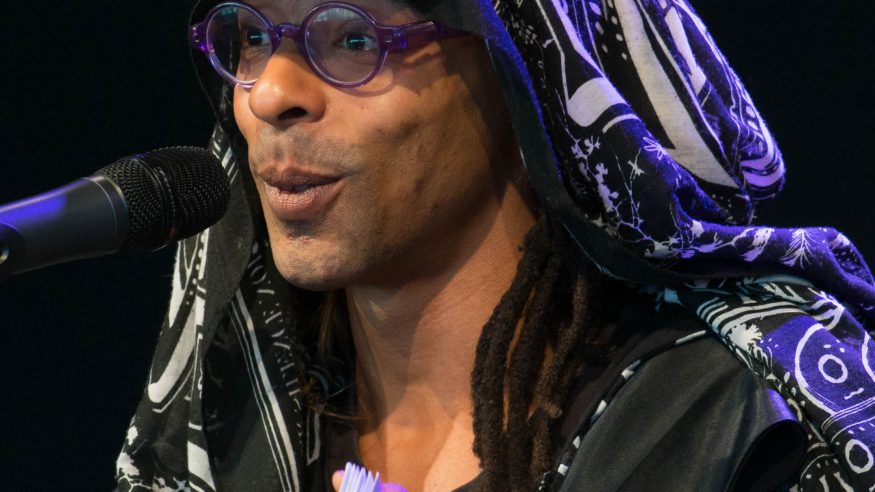Slurring Images
4 March 2024
// content warning: racist language and racist imagery //
In 2012, the Swedish artist Makode Linde displayed an extremely controversial work of art at the Modern Museum in Stockholm. In celebration of World Art Day, Painful Cake was shown at a reception attended by the Swedish Culture minister. The work comprised the artist, who is an Afro-Swedish man, with a Golliwog-painted face as the head of a cake in the shape of a caricatured black woman. Linde would scream when viewers cut into the cake, referencing FGM. The piece was part of the artist’s project ‘Afromantics’, which uses blackface imagery on Western icons and Greek gods.
The Swedish Culture minister smiled and laughed as she cut into what’s now-known as the ‘Hottentot Venus Cake’, while onlookers grinned and filmed the spectacle on their phones. At one point, the minister fed a slice of cake – which had just been cut in a clitoridectomy gesture – to the artist himself, in a bizarre representation of cannibalism. [See here for a video of the event. Content Warning: includes racist imagery]
An uproar in Sweden followed: the event was reported to the Parliamentary Ombudsman, and the National Association of Afro Swedes demanded the Minister’s resignation. The debate was divided between those who conceded that the work was distressing but insisted that it revealed contemporary racism and was not itself racist, and those who deplored the work for being racist and degrading to women despite the artist’s intentions. The ‘Open Letter from African women to the Minister of Culture’ posted on the Afro-Nordic blog MsAfropolitan, for instance, argued that the artwork was an appalling spectacle of misogynoir. The Minister, however, defended the artist:
I am the first to agree that Makode Linde’s piece is highly provocative since it deliberately reflects a racist stereotype. But the actual intent of the piece — and Makode Linde’s artistry — is to challenge the traditional image of racism, abuse and oppression through provocation.[1]
While Linde is explicitly anti-racist, something still went wrong with this work which outstrips the horror he was aiming to create. Here I want to propose a partial explanation of what went wrong: the central parts of this artwork constitute an ‘aesthetic slur’. And the toxicity of these special images leaks out despite the artist’s intentions.
We normally think of slurs as being linguistic expressions, which carry a heavy moral and emotional load. They are pejoratives used to offend, denigrate, or subordinate another person or group in virtue of their group membership. And those who are targeted are normally branded by the slur as somehow lesser, or even as less than human (Green 2021: 145).
Slurs have many significant characteristics, but most relevant for my purposes here is their ‘projectile’ or ‘effluent’ character: even if embedded in quotations or speech reports, or said with negligent or good intentions, the very mention of them by a member of the non-target group seems to commit that speaker to the pejorative content; it “risks complicity” (Anderson & Lepore, 2013: 354). Saying, “Daryl said he wants a ch*nky for dinner” preserves the slurring effect even though it’s a report of what someone else has said. Generally, the harm of slurs can leak out regardless of the speaker’s intention or use of the term.
There appear to be visual instances of these expressions – images that behave in the same way, and which needn’t be direct visual correlates. I propose that the aesthetic slur is a distorting iconic representation – ‘iconic’ in being a depiction or representation of something involving some degree of assumed stereotypical resemblance, and ‘distorting’ in that it invites viewers to see the depicted subject as having features it does not in reality have (DiFranco 2017: 794).
We can begin to note some characteristics of such slurring images. First, they are caricatural: stereotypical features of the target group are aesthetically (visually, sonically) emphasised or distorted, for example skin colour, mouth shape/colour, clothing, speech, and mannerisms. In particular, the aesthetic qualities that are emphasised will likely derive from what Patricia Hill Collins (1990) calls “controlling images”: broad stereotypical concepts or ideas which pervade a culture and the social imagination, such as the racist ‘Mammy’ and ‘Jezebel’ figures. The aesthetic slur is basically a visual manifestation of these harmful concepts – its composite image forms a prototype which remains stable across contexts. We can immediately detect, for example, the Golliwog slur in different situations: in an illustrated novel, a doll, a cartoon, or an artwork.
Aesthetic slurs, like other non-verbal pejoratives, sting: they have “an immediate, visceral reaction: one may feel shocked or offended as a result…” upon seeing one (DiFranco, 2017: 789). They also have ‘sullying’ effects, where their use “leads audiences to entertain objectionable thoughts […] which characteristically have certain negative long-term psychological effects on recipients” (DiFranco, ibid). Moreover, aesthetic and linguistic slurs share the property of effluence. Depending on who uses them, their harmful content or sting can leak out despite the user’s intention.
You’ve probably already thought of several aesthetic slurs along these lines. Here are some examples.
Antisemitic imagery These images were used as far back as the Middle Ages and then in Nazi propaganda, which served to demonise Jewish people by portraying them with hooked noses, horns, miserly demeanours, and even as non-human. They also use common tropes such as zoomorphism, where Jewish people are portrayed as animals like octopuses and snakes, and even bloodsucking vampires.[2]
The Golliwog figure A 19th century doll-like character created by the author Florence Kate Upton became a striking anti-black image with its minstrel attire and appearance of jet-black skin and wide red lips. The character entered the public domain appearing as children’s toys, on postcards, wallets, perfume bottles, greeting cards, and even jewellery. Today, we can see it in Stroud’s statue of the ‘Black Boy Clock’, which has been called a “cast iron golliwog”.[3]
The Jezebel/Hottentot Venus figure The portrayal of black women as naturally hypersexual; an enduring stereotype used to justify sexual violence in slavery, and which was derived from the appalling objectification of Sarah Bartmann in the 19th century (Collins 1990: 81). The image itself appears in cartoons, household décor, and objects like metal nutcrackers and swizzle sticks, and even fishing lures.
Blackface performance Originating in 19th century US minstrel performances, where white performers insultingly mimic black people by making up their faces with burned cork, and with wide red or white lips. They light-heartedly present a derogatory conception of blackness, drawing on ideas of laziness, ignorance, sexual promiscuity, and contentment with oppression (Zheng & Stear 2023: 393-394).
These are just a few instances of what I’ve called ‘aesthetic slurs’. They each have a certain prototype – a visual composite of distorted features – which manifests in all manner of objects and contexts.
Returning to Painful Cake, we could argue that Linde used the aesthetic slurs of the Golliwog and Hottentot Venus to pose a post-colonial critique. In fact, he did explicitly explain that the cake symbolised how white people consumed black people.
However, Linde’s use of the Golliwog and Hottentot Venus slurs meant that the harms of these images leaked out despite his identity, or even because of his identity as a man. Indeed, the artist’s gender was a major factor in the MsAfropolitan objection – it reinscribed the violence the work was trying to denounce. Having a black man speak on behalf of black women in the form of art, at least in this extreme case, could be considered a breach of intimacy. Despite Linde being black, his not being a black woman rendered his Painful Cake for many (but of course not all) a violation of a boundary set by many black women. The slurring images were not his to use, and he overstepped a line. His use of these aesthetic slurs meant that his artwork’s toxicity was taken at face-value.
In Linde’s defence, we could argue that he had reclaimed the aesthetic slur of at least the Golliwog. And of course, linguistic slurs are often appropriated or reclaimed, where they are co-opted by the target group who begin using the slur in a non-slurring, liberated way. But aesthetic slurs seem to resist this. Perhaps they are even more visceral than linguistic slurs because of their perceptual content – their aesthetic properties pack more of a punch, which cannot be inoculated over time with liberatory uses. Indeed, expressing dangerous sentiments through imagery, art and entertainment is what makes these dangers so much more sinister and powerful. A picture is worth a thousand words.
Word count: 1393
Anderson, Luvell & Lepore, Ernie (2013) ‘What Did You Call Me? Slurs as Prohibited Words’ Analytic Philosophy 54 (3):350-363.
Collins, Patricia Hill (1990) Black Feminist Thought (Hyman).
DiFranco, Ralph (2017) ‘Derogation without words: On the power of non-verbal pejoratives’ Philosophical Psychology 30 (6):784-808.
Green, Mitchell (2021) The Philosophy of Language (Oxford University Press).
Zheng, Robin & Stear, Nils-Hennes (2023) ‘Imagining in Oppressive Contexts, or What’s Wrong with Blackface?’ Ethics 133 (3):381-414.
[1] https://government.se/ quoted in: http://www.jeremyriad.com/blog/art/edible-art/swedish-performance-art-cake/
[2] https://antisemitism.org.uk/wp-content/uploads/2020/07/Antisemitic-imagery-May-2020.pdf
[3] https://www.stroudnewsandjournal.co.uk/news/19494329.blackboy-clock-stroud-statue-cast-iron-golliwog/
Photo of Makode Linde by Frankie Fouganthin – Own work, CC BY-SA 4.0, https://commons.wikimedia.org/w/index.php?curid=38589614
- October 2025
- September 2025
- August 2025
- July 2025
- June 2025
- May 2025
- April 2025
- March 2025
- February 2025
- January 2025
- December 2024
- November 2024
- October 2024
- September 2024
- August 2024
- July 2024
- June 2024
- May 2024
- April 2024
- March 2024
- February 2024
- January 2024
- December 2023
- November 2023
- October 2023
- September 2023
- August 2023
- July 2023
- June 2023
- May 2023
- April 2023
- March 2023
- February 2023
- January 2023
- December 2022
- November 2022
- October 2022
- September 2022
- August 2022
- July 2022
- June 2022
- May 2022
- April 2022
- March 2022
- February 2022
- January 2022
- December 2021
- November 2021
- October 2021
- September 2021
- August 2021
- July 2021
- June 2021
- May 2021
- April 2021
- March 2021
- February 2021
- January 2021
- December 2020
- November 2020
- October 2020
- September 2020
- August 2020
- July 2020
- June 2020
- May 2020
- April 2020
- March 2020
- February 2020
- January 2020
- December 2019
- November 2019
- October 2019
- September 2019
- August 2019
- July 2019
- June 2019
- May 2019
- April 2019
- March 2019
- February 2019
- January 2019
- December 2018
- November 2018
- October 2018
- September 2018
- August 2018
- July 2018
- June 2018
- May 2018
- April 2018
- March 2018
- February 2018
- January 2018
- December 2017
- November 2017
- October 2017
- September 2017
- August 2017
- July 2017
- June 2017
- May 2017

